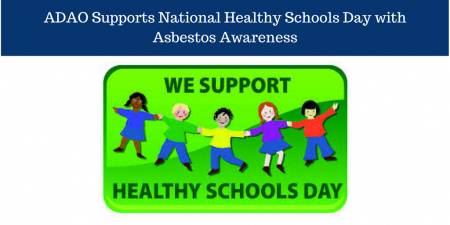Posted April 3, 2018
ADAO Supports National Healthy Schools Day with Asbestos Awareness
 On April 3rd, 2018, parents, teachers, school nurses, custodians, advocates, and agencies from nearly 60 partners unite in their efforts to promote the 16th Annual National Healthy Schools Day. On this important day of action, it is critical to educate our communities on where asbestos is in our schools and how to make sure students and staff are safe.
On April 3rd, 2018, parents, teachers, school nurses, custodians, advocates, and agencies from nearly 60 partners unite in their efforts to promote the 16th Annual National Healthy Schools Day. On this important day of action, it is critical to educate our communities on where asbestos is in our schools and how to make sure students and staff are safe.
The Scope of the Problem
In 1984, the United States Environmental Protection Agency (EPA) estimated “that there are asbestos containing materials in most of the nation’s approximately 107,000 primary and secondary schools and 733,000 public and commercial buildings.” What’s worse—the EPA survey found that “approximately 34,800 schools were believed to have friable ACM
In 2015, U.S. Senators Barbara Boxer and Ed Markey conducted an investigation to see how schools were protecting students, teachers and staff from asbestos exposure. What they found confirms that the widespread, poorly managed risk of asbestos contamination in America’s schools is as bad as ever.
The report from this investigation, “Failing the Grade: Asbestos in America’s Schools”, revealed that as of 2015:
- More than two-thirds of state education agencies reported having schools that contain asbestos, most of which has been left in place.
- School districts do not appear to be systematically monitoring, investigating or addressing asbestos hazards in schools, or keeping records.
You don’t have to look hard—or far from home—to find a story of asbestos exposure in schools. Students in Cedar Grove, New Jersey are starting this school year in temporary classrooms in another county after tests during a construction project over the summer revealed elevated levels of asbestos in some school buildings.
In 2014, the Huntington Beach School District suddenly closed three schools after receiving results confirming the presence of asbestos in classrooms, displacing hundreds of students for months, sometimes even years. The district was forced to spend millions in costs related to the emergency abatement—the total unexpected expenditures are estimated at $6 million per school, or $18 million collectively, which included a weekly $50,000 expense for busing the displaced students to other schools.
What You Can Do
Ultimately there needs to be a better system of oversight put into place to ensure AHERA offers the protection it is intended to provide. Until then, though, parents must take on the watchdog role. No one has more at stake in this, and no one has more of a right to force a change. If you request information, the school district is required by law to respond.
Following these simple steps can help parents prevent exposure at school:
- Educate yourself about the dangers of asbestos exposure
- Inspect the school’s asbestos management plan
- If you suspect danger, seek answers and guidance from the Environmental Protection Agency (EPA)
Fighting for a Better Future
The federal government must take seriously the threat of exposing our schoolchildren to asbestos and take steps to rectify the poor enforcement of AHERA, an incredibly important, lifesaving law. The EPA has long known of the dangers of asbestos—so much so that they tried to ban it in 1989, only to have the ban overturned by litigation. If the evidence against asbestos was conclusive enough to push for a ban nearly 30 years ago, it should be sufficient reason to ensure America’s children are protected from it.
The EPA was recently empowered to finally follow through on that failed ban by the enactment of The Lautenberg Act reforms to our chemical safety laws. Perhaps if the EPA fields enough asbestos-in-schools complaints from concerned parents, they’ll begin to understand why it is so crucial that they start taking much needed federal action against this silent killer that has remained legal and lethal for far too long.
As Sen. Boxer wrote in an August 2016 letter to the EPA, federal regulatory action on asbestos is necessary “to build confidence in the agency’s ability to deliver meaningful results for our children and families.”
Parents have more than enough to worry about when they send their kids off to school these days; the entirely preventable threat of asbestos exposure shouldn’t have to be on that list of concerns.
On this day of education, advocacy, and action, take a few moments to help keep our schools safe from deadly toxins by spreading asbestos awareness.
Together, change is possible.
Linda Reinstein
Social Networks
